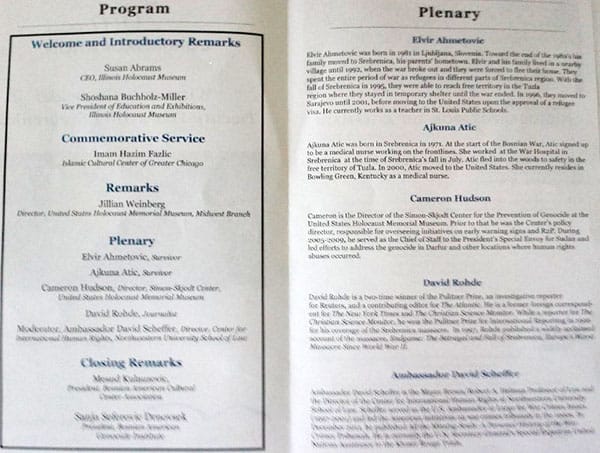
„20th COMMEMORATION. Witness to Genocide. Twenty Years After Srebrenica” took place at the Illinois Holocaust Museum & Education Center on Sunday, July 19, 2015. Several hundred people attended this special Commemoration. Some of the attendees were survivors, other worked as the American diplomats, journalists, others were children and grandchildren of people who experienced this traumatic human tragedy. There were numerous people from the Bosnian-American Community.
The main 20th Anniversary Commemoration of this tragedy took place in Srebrenica a week before with thousands of people in attendance. The American delegation was nominated by President Obama. One of the key speakers was Bill Clinton, former United States President.
The Srebrenica massacre, also known as the Srebrenica genocide ( Bosnian: Genocid u Srebrenici), was the genocidal killing, in July 1995, of more than 8,000 Muslim Bosniaks, mainly men and boys, in and around the town of Srebrenica during the Bosnian War. [Source: Wikipedia]
Susan Abrams, CEO of the Illinois Holocaust Museum made introductory remarks.
Shoshana Buchholtz-Miller, Vice President of Education and Exhibitions, Illinois Holocaust Museum played major role in helping to bring exhibit “Abandoned At Srebrenica: Photographs from the Aftermath”, to the Museum to organize the Commemoration event.
Panelists at the Holocaust Museum: Amb. David Sheffer – Moderator of the Plenary Discussion; David Rohde, a journalist; Cameron Hudson, United States Holocaust Museum; Elvir Ahmetovic, Survivor; Ajkuna Atic, Survivor.
Ajkuna Atic was born in Srebrenica in 1971. At the beginning of the Bosnian War, Atic signed up to be a medical nurse working on frontlines. She worked at the War Hospital in Srebrenica at the time of Srebrenica’s fall in July 1995. Atic fled into the woods to safety in the free territory of Tuzla. In 2000, Atic moved to the United States. She works as a medical nurse.
“ We are here as survivors. We want to tell youth, future generations, so it will never happen again”, said Ajkuna Atic.
She described her survival in the woods during the Bosnian war. She saw many people suffering, dying. She felt overwhelmed. There were not enough medications, medical help to help thousands of people.
Elvira Ahmetovic was born in 1981 in Ljubljana, Slovenia. Towards the end of the 1980’s his family moved to Srebrenica, his parents’ hometown. Elvir and his family lived in a nearby village until 1992, when the war broke out and they were forced to flee their home. They spent the entire period of war as refugees in different parts of Srebrenica region. He described his childhood memories of losing his uncle, his sister and other relatives during the war. They stayed in temporary shelters in Tuzla region until the war ended in 1995. They were approved as the war refugees by the United States government and moved in to the USA in 2001. He currently works as a teacher.
“Srebrenica is the most scientifically documented war crime in history”, stated David Rohde, a journalist who won the Pulitzer Prize for International Reporting in 1996 for his coverage of the Srebrenica massacre, during the discussion.
In 1997, Rohde published a widely acclaimed account of the massacre, Endgame: The Betrayal and Fall of Srebrenica, Europe’s Worst Massacre Since World War II.
Rohde made another powerful statement during the discussion about the Srebrenica tragedy at the Holocaust Museum by saying “It was a collective failure”.
Ambassador David Scheffer was the Moderator of the Plenary discussion on the 20th Anniversary of the Srebrenica Massacre. He serves as the Mayer Brown/Robert A. Helman Professor of Law and the Director of the Center for International Human Rights at Northwestern University School of Law.
Scheffer served as the United States Ambassador at Large for War Crimes Issues (1997-2001) and led the American initiatives on war crimes tribunals in the 1990s. In December 2011, he published All the Missing Souls: A Personal History of the War Crimes Tribunals. He is currently the U.N. Secretary-General’s Special Expert on United Nations Assistance to the Khmer Rouge Trials.
My goal to attend this special 20th Commemoration of Srebrenica tragedy was to better understand the historical facts related to it, to hear personal testimonies of witnesses of these tragic events and to better understand the Bosnian American Community in USA.
I asked panelists how many war refugees from Bosnia-Herzegovina came to the United States. The number that I got from the panelists and community leaders is estimated between 350,000-400,000. Many of these war refugees, immigrants from Bosnia and Herzegovina still remember these tragedies; carry physical and emotional wounds from this great tragedy. They try to rebuild their lives in the United States and they hope to find justice for these human sufferings in the International War Crime Tribunal.
@ Andrew (Andrzej) Mikolajczyk



